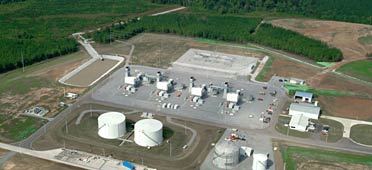Kemper Combustion Turbine Plant

Kemper is one of 12 combustion-turbine sites in the TVA power system and TVA’s first major generating plant in Mississippi. Its four units have a combined summer capability of 312 megawatts.
The 197-acre Kemper facility helps reduce the need for TVA to purchase higher-priced power from external sources during periods of high demand. The plant site was chosen because it’s close to a major natural-gas pipeline and TVA transmission lines. Its location also helps increase the reliability of electric service to customers in northeast and central Mississippi.
Efficient power production to help meet peak demand
Combustion turbines can run on natural gas or low-sulfur fuel oil and are designed to start quickly to meet the demand for electricity during peak operating periods. The units at Kemper can reach full power in just 20 minutes.
While the units are used primarily as peaking units, the Kemper plant can produce enough electricity to power about 200,000 homes.
Combustion turbines operate on the same principle as a jet engine. Air entering each unit is compressed, mixed with natural gas or oil, and ignited. The hot gas then expands through turbine blades to turn generators and produce electricity.
State-of-the-art emission controls and noise management make the Kemper units more environmentally friendly than older types. When running on natural gas, Kemper's nitrogen-oxide emissions are 10 percent less than from combustion turbines built 30 years ago; when running on oil, emissions are 20 percent less than from older units.